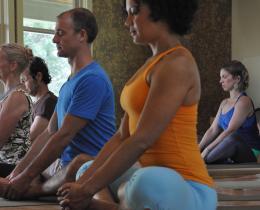Retreats and yoga classes for veterans and their families are springing up nationwide. Programs that train veterans and yoga teachers in sharing yoga with veterans exist in surprising numbers. And for good reason.
The transition home from active duty is not an easy one: As many as 35 percent of soldiers serving in Iraq and Afghanistan are expected to suffer from mental health issues upon their return. The challenges of veterans reintegrating into society are complex. The implications of post-traumatic stress disorder (PTSD), often referred to as an invisible wound, manifest in homelessness, drug use, spousal abuse, and suicide.
According to the military, more active duty soldiers die from suicide than from combat. In 2012, 349 members of the armed forces took their own lives. A new study of veteran suicides from 1999 to 2010 shows that the number is estimated to be around 22 suicides a day.
Yoga programs for veterans address issues related to PTSD, which is the onset of reactions to events that are due to upsetting memories of the traumatic event. PTSD can manifest in many ways, but often includes hypervigilance or trouble sleeping.
Many programs, such as Yoga Warriors, which offers classes for soldiers in more than 29 states, are designed specifically to assist soldiers in coping with post-traumatic stress, as well as the daily and specific stresses that military members experience.
But how exactly does yoga support healing from PTSD? Researchers and scientists are working hard to answer this question.
In the interview Yoga and Post-Traumatic Stress Disorder in Integral Yoga Magazine, Bessel van der Kolk, clinician, researcher, and teacher in the area of post-traumatic stress since the 1970s, speaks to how trauma resides in the body and why this makes yoga a supportive modality for healing:
“Traumatized people often are terrified of the sensations in their own bodies. Most trauma-sensitive people need some form of bodyoriented psychotherapy or bodywork to regain a sense of safety in their bodies...People with PTSD lose their way in the world. Their bodies continue to live in an internal environment of the trauma. We all are biologically and neurologically programmed to deal with emergencies, but time stops in people who suffer from PTSD. That makes it hard to take pleasure in the present because the body keeps replaying the past. If you practice yoga and can develop a body that is strong and feels comfortable, this can contribute substantially to help you to come into the here and now, rather than staying stuck in the past.”
Other ways that yoga supports healing for veterans with PTSD, according to van der Kolk are that: “Yoga helps regulate emotional and physiological states. It allows the body to regain its natural movement and teaches the use of breath for self-regulation.”
Preliminary results from a study led by Harvard Medical School assistant professor, Sat Bir S. Khalsa, and funded by the United States Defense Department, found that veterans diagnosed with post-traumatic stress disorder experienced improvement in their symptoms after 10 weeks of yoga classes that included breathing exercises and meditation as well as a daily practice at home.
In an interview, Khalsa, says: “PTSD is a disorder involving dysregulation of the stress response system, and one of the most powerful effects of yoga is to work on cognitive and physiological stress.”
Essentially, yoga practices enable veterans to begin to rewire the mind-body responses to events that trigger PTSD behaviors (such as panic in response to loud noises). Yoga allows practitioners to address the fight-or-flight response, which is the response that dictates PTSD behaviors.
Because yoga provides access to and connection between the mind and body, it allows one to overwrite the fight-or-flight response over time, by integrating yoga postures, breathwork, and meditation.
Working with students with PTSD requires that practitioners and teachers develop and build upon their knowledge of trauma and PTSD treatments that are effective. The United States Department of Veteran Affairs offers PTSD 101 training models for professionals through their website. Because of the seriousness of PTSD, it is critical that practitioners offering this work, do so after completing training, and that they commit to regular interaction with professionals in the field. A relationship with an organization, more experienced mentor or teacher, or mental health professional will help ensure that yoga teachers offering this work are held accountable to best practices.
As the United States military adopts more evidence-based, mind-body approaches and seeks to hire competent instructors, specialized training focused on military culture and combat-related conditions will be a great benefit.



